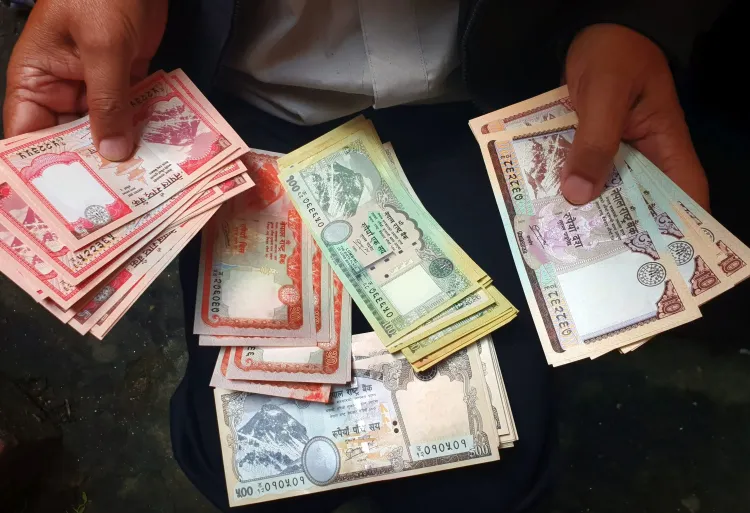Could RBI Policy Enhance Financing for Nepalese Businesses?

Synopsis
Key Takeaways
- The RBI's policy opens new financing avenues for Nepali businesses.
- Indian banks may provide loans at competitive interest rates.
- Nepali firms could face challenges in loan repayment.
- Increased dependence on Indian financing is a potential concern.
- Current low interest rates may deter borrowing from abroad.
Kathmandu, Oct 6 (NationPress) The Reserve Bank of India (RBI) has made a significant announcement that could pave the way for enhanced financing options for Nepali businesses. The RBI's recent policy allows selected Indian banks to extend loans in Indian rupees to residents of Nepal, Bhutan, and Sri Lanka, as per insights from top local experts.
On October 1, the RBI declared its decision to permit Authorised Dealer (AD) banks in India, along with their overseas branches, to lend in Indian currency to individuals and banks in these neighboring countries, thereby facilitating cross-border trade.
AD banks, which are authorized for engaging in foreign exchange transactions, include prominent institutions like State Bank of India, Punjab National Bank, HDFC Bank, ICICI Bank, and Axis Bank.
The primary objective of India's Central Bank is to promote the settlement of cross-border transactions in Indian rupees. While the RBI has yet to outline the specific terms and conditions for lending to these countries, it has assured that amendments will be communicated soon.
Officials from Nepal's Central Bank believe this policy shift could greatly assist Nepali companies in securing loans from Indian banks, especially as the Nepal Rastra Bank (NRB) has already opened avenues for foreign loans to Nepali individuals and businesses.
In 2021, the NRB introduced borrowing under specific conditions, including an interest rate cap. Currently, Nepali entities can borrow up to one million US dollars from relatives or non-resident Nepalis, or up to 100 million Indian rupees specifically from India, although these funds are restricted from being invested in housing, real estate, or the stock market.
Despite these provisions, there are few instances of Nepali businesses obtaining loans from foreign banks, although local banks have borrowed from international institutions for targeted investments.
“It is not immediately evident what the lending criteria will be for Indian banks in Nepal,” remarked a senior NRB official to IANS. “Nonetheless, the prospect of Indian banks lending to Nepali residents is a positive development, aligning with Nepal's Central Bank policy. Challenges may arise for companies that do not generate sufficient income to repay loans,” he elaborated.
Nara Bahadur Thapa, former Executive Director of NRB, emphasized that the RBI's decision could enable Nepali firms to access loans at more competitive interest rates. “This means Nepali businesses won't have to depend solely on local banks, which will push our banks to enhance their competitiveness,” he noted. Thapa added that Nepali firms might choose Indian banks when domestic rates rise.
Currently, interest rates in Nepal are low, with banks offering loans below seven percent for housing and auto purchases. “As it stands, Nepali banks are providing loans at very attractive rates, which may deter companies from seeking loans abroad,” the NRB official mentioned. Historically, however, the Nepali banking sector has faced significant liquidity challenges when interest rates increase.
Nepali banks, however, have limitations in their lending capacities. “The banking sector in Nepal cannot finance large-scale infrastructure projects, like 1,000 MW hydropower projects, without exceeding the single-customer lending cap,” stated economist and former NRB Executive Director Keshav Acharya.
With Nepal targeting the development of 28,500 MW of electricity within the next decade—up from nearly 4,000 MW currently—it will require an investment of approximately US$46.5 billion, as outlined in the Energy Development Roadmap 2025.
“Indian banks possess more substantial funding capabilities for large infrastructure projects, and those involved in such developments in Nepal may secure loans from Indian banks,” Acharya conveyed to IANS.
However, it's important to note that loans from Indian banks will exclusively be disbursed in Indian currency. This means a Nepali company looking to source materials for a project may need to rely heavily on the Indian market, as the Indian currency is not universally accepted at this time.
“This indicates that Nepal's long-standing economic dependence on India may intensify,” Acharya remarked. The informal trade between Nepal and India is significant due to their open border, with Nepal heavily relying on India for both exports and imports.
Nepal's bilateral trade with India constitutes over 60 percent of its total foreign trade. In the last fiscal year 2024–25, ending mid-July, Nepal exported goods valued at NPR 224 billion to India, while imports from India amounted to NPR 1,071 billion. India's participation in Nepal’s international trade was recorded at 62.3 percent, according to the NRB.
Given the extensive trade with India, Nepal has been consistently selling convertible foreign currencies—such as the US dollar—to acquire Indian rupees, facilitating Nepali traders in importing goods from India. The bulk of Nepal's foreign exchange reserves is attributed to the remittances from its overseas population.
“One advantage of Indian banks lending to Nepali businesses is that it could reduce the necessity for Nepal to sell US dollars to buy Indian currency, thus saving on commission fees for such transactions,” Acharya concluded.









